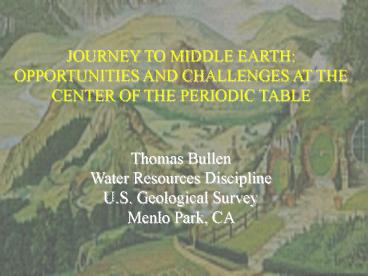JOURNEY TO MIDDLE EARTH: PowerPoint PPT Presentation
1 / 15
Title: JOURNEY TO MIDDLE EARTH:
1
JOURNEY TO MIDDLE EARTH OPPORTUNITIES AND
CHALLENGES AT THE CENTER OF THE PERIODIC TABLE
Thomas Bullen Water Resources Discipline U.S.
Geological Survey Menlo Park, CA
2
Cover of book released at 2-day MSA short course
on non-traditional stable isotopes held May
15-16, 2004 in Montreal, Canada
3
OPPORTUNITIES GALORE
- Until only a few years ago, I would never have
imagined that a volume on the stable isotope
geochemistry of elements such as Mg, Fe or Cu
would be written. I am about ready to eat those
words (Jim ONeil)
- It appears that Mg in waters is related to
mantle and crustal reservoirs by kinetic
fractionation while Mg in carbonates is related
to the waters by equilibrium processes (Ed Young)
- Very little is known about the isotopic
composition of Cu and Zn in biological material
(Francis Albarede)
- There is a major gap in our ability to measure
stable isotope fractionations and our
understanding of the processes that cause
fractionations to occur (Ed Schauble)
- Fractionation factors for Ca isotopes, their
causes, magnitude, temperature dependence and
ubiquity in metabolic processes are still poorly
understood (Don DePaolo)
4
WHY WE ARE HERE
5
THE MAJOR PLAYERS AT A GLANCE
- Li isotopes fractionated during weathering
highly fractionated anthropogenic pool out in
environment
- Mg fractionated by equilibrium processes during
carbonate formation central component of
chlorophyll molecule
- Ca fractionated by plants and bone
fractionation in carbonates may depend on
temperature, growth rate, nutrient supply,
- Cr fractionated during reduction of toxic Cr(VI)
to Cr(III)
- Fe significant equilibrium fractionation between
Fe(II) and Fe(III) abiotic and biotic
fractionations indistinguishable
- Cu and Zn fractionations observed in ore
deposits and sediments important enzymatic
functions
- Se fractionated during reduction of toxic Se(VI)
to Se(0)
- Mo fractionated during sorption of Mo(VI)
important paleo-redox applications as indicator
of euxinic conditions
6
SOME OTHER DENIZENS OF MIDDLE EARTH
7
NEW UNDERSTANDING AT THE PROCESS-LEVEL
Sorption on d-MnO2
Barling and Anbar, 2004
Ellis et al., 2002
Cr reduction kinetic fractionation e
(CrO42- - Cr(III)) 1.0034
Mo sorption equilibrium fractionation a
(MoO42-aq - xMoxsorb ) 1.0018
8
DISTINGUIISHING KINETIC AND EQUILIBRIUM PROCESSES
What about Si??
Or Ca??
Young and Galy, 2004
9
(No Transcript)
10
(No Transcript)
11
(No Transcript)
12
ANALYTICAL CHALLENGES
With the Neptune, it is possible to obtain a lot
of very precise stable isotope data very quickly
- But is the data accurate?
13
JUST ANOTHER DAY FOR THE NEPTUNE
- Based on repeated TIMS double spike analysis
- d56Fe of ICP-Fe solution -0.19 relative to
BIR-1 basalt
- Column-processed ICP-Fe and BIR-1, measured using
standard-sample-standard approach - d56Fe of ICP-Fe solution 0.24 relative to
BIR-1 basalt
- Column-processed ICP-Fe and BIR-1 with Cu
internal standard, measured using
standard-sample-standard approach - d56Fe of ICP-Fe solution -0.63 relative to
BIR-1 basalt
- Column-processed ICP-Fe and BIR-1, with Fe double
spike - d56Fe of ICP-Fe solution -0.19 relative to
BIR-1 basalt
14
SAMPLE-RELATED SOURCES OF BIAS
15
TOMS TOP 10 CHALLENGES
1. Challenge everything you read
2. More women in the field!
3. Use appropriate internal standardization
4. Duplicates Duplicates Duplicates
5. Design experiments that answer the question
6. Consider your element in major- and trace
element settings
7. Beware of standard-sample-standard
bracketing
8. Keep the chemistry clean and sample
preparation constant
9. Dont forget TIMS
10. Challenge everything you read

